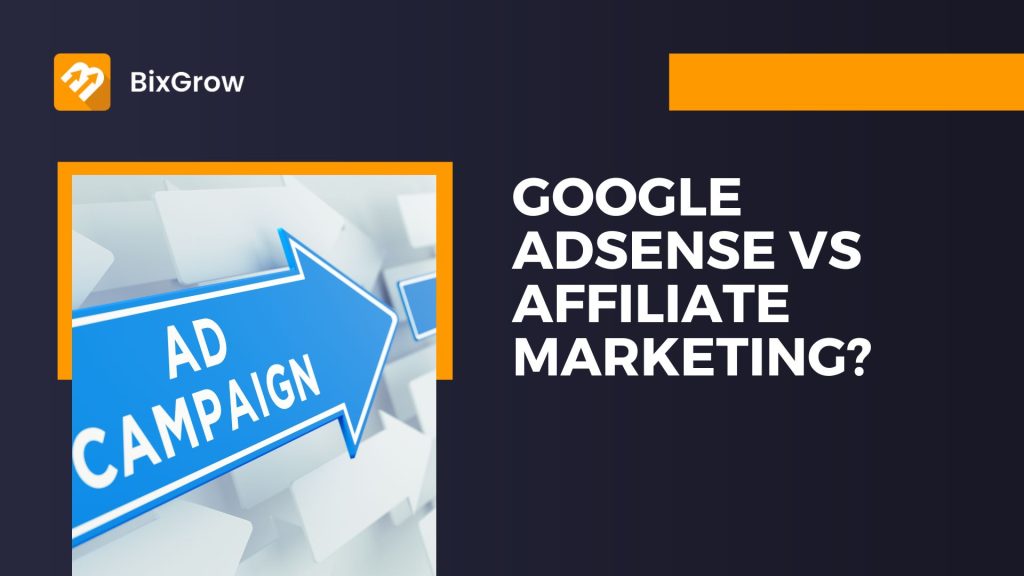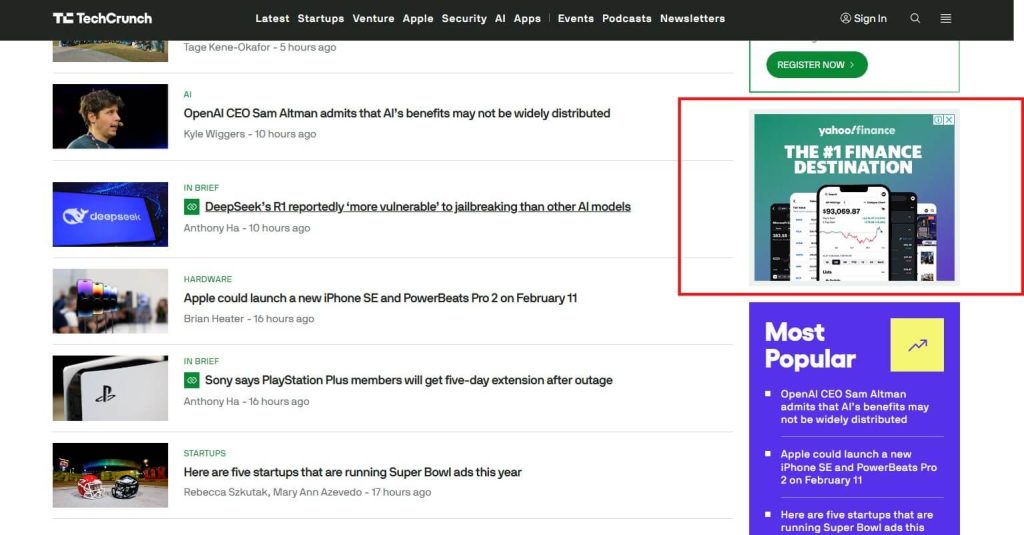In MMO, marketers question among Google AdSense vs affiliate marketing, which one is better for marketers and bloggers alike?
In this article, we will explore the fundamentals of both Google AdSense and affiliate marketing, explore their differences, and provide insights on how your blog content and audience behavior can influence your choice between the two.

What is affiliate marketing?
Affiliate marketing is a performance-based marketing model where individuals or companies (affiliates) earn a commission by promoting another business’s products or services. Simply put, affiliates are the middlemen, driving traffic or sales to a merchant’s site through unique referral links, and in return, they receive a payment, usually a percentage of the sales.
Affiliates are paid based on the sales or leads they generate, making it a risk-free model for merchants, as they only pay for actual results. This can lead to very high ROI rate, which can stay around 1,400% for some brands
Affiliate marketing grow rapidly. The total spending for this method in the U.S. is expected to grow at CAGR 18.6% by 2032, highlighting earning potential for content creators and influencers.
For instance, a website like The Wirecutter focuses solely on affiliate marketing. It offer in-depth product reviews with affiliate links to online stores. Their earnings come from commissions made on sales generated by readers clicking on their links.

Affiliate marketing offers a significant earning potential, especially when targeting niche markets with high-ticket items or subscription-based services. By integrating affiliate links into your content, you can monetize your platform while still provide valuable recommendations to your audience.
What is Google Adsense?
Google AdSense is an advertising program developed by Google. It allows website owners and bloggers to monetize their websites by displaying ads. Through this platform, content creators can earn revenue by having ads placed on their site, with earnings based on the number of ad impressions (CPM) or clicks (CPC) received. As of 2020, Google AdSense was used by more than 2 million websites worldwide, being one of the biggest ad platform ever.
Google AdSense offers a variety of ad types, including text ads, display ads, and video ads. These ads are automatically matched to the content of your website and audience. Hence, webmasters can integrate them easily into their content & canoptimize for the best conversion rate.
Unlike affiliate marketing, which requires partnerships and product promotion, AdSense is easy to set up by simply placing a snippet of code on your website. Google takes care of the rest, including finding advertisers and placing relevant ads.
For example, a website like “TechCrunch” displays a variety of ads through AdSense. The site gets millions of pageviews per month, earning revenue based on clicks and impressions across its articles.

Google AdSense offers an easy and scalable solution for monetizing a website. While the ad revenue may be lower per individual user compared to affiliate marketing, it provides an ongoing, automated revenue stream for bloggers and website owners, especially those with large traffic volumes.
Google AdSense vs affiliate marketing: Key differences
While both Google AdSense and affiliate marketing are effective ways to monetize a website, they operate differently, and understanding these differences is crucial for choosing the best option for your site.
Revenue model: Pay-per-click vs. Commission-based
- As a cost-per-click (CPC) or cost-per-thousand-impressions (CPM) model, AdSense pays you based on the number of clicks or impressions an ad receives. The more traffic your site gets, the more you can potentially earn.
- With affiliate marketing, you earn a commission when a user makes a purchase or completes a desired action (e.g., sign-up or subscription) through your referral link. Earnings are tied to actual sales or actions, making the potential payout higher but less predictable.
Control over monetization
- AdSense automatically places ads based on your website’s content and your audience’s behavior. You have little control over which specific ads appear, though you can block certain categories or advertisers.
- In affiliate marketing, you have more control. You can choose the products or services to promote, select affiliate networks or merchants, and even create custom promotional content (e.g., reviews, and tutorials).
Setup and maintenance effort
- Setting up AdSense is relatively simple. After signing up, you get a snippet of code to add to your site, and Google automatically handles the ad placement and management. There’s minimal ongoing effort, but the earnings can be slow without substantial traffic.
- Affiliate marketing requires more effort in setting up partnerships, choosing the right affiliate programs, and creating content that encourages purchases. However, it can yield higher earnings per sale compared to AdSense, especially if you’re promoting high-ticket items.
Earnings potential
- With AdSense, the earning potential depends largely on your traffic volume and the types of ads being displayed. Sites with high traffic (but low engagement) might generate substantial ad revenue, but the earnings per user will be smaller.
- Affiliate marketing typically offers higher commissions per sale, especially if you’re promoting high-value products or services. However, the earnings can fluctuate depending on how effectively your promotional content drives conversions.
Ideal for content types
- Google Adsense is ideal for informational websites, blogs, or news sites where visitors are looking for content but not necessarily to make a purchase. AdSense works best for sites with a broad, general audience.
- Affiliate marketing works best for niche websites or blogs that cater to a specific audience with purchasing intent. If your content revolves around product reviews, tutorials, or comparison guides, affiliate marketing can be more profitable.
Google AdSense vs affiliate marketing: Best choice for blogger?
The type of content you produce on your blog plays a significant role in determining whether Google AdSense or affiliate marketing is a better fit for your monetization strategy. Understanding your content style and your audience’s behavior can help you choose the right method.

Before choosing between AdSense and affiliate marketing, review the following:
- Content type: If you focus on selling products or services through your content (e.g., reviews, recommendations), affiliate marketing is the way to go. For general informational or entertainment content, AdSense will be a better match.
- Audience intent: Understand your audience’s behavior. Are they likely to purchase something, or are they just looking for information? This can help you determine if you need high-traffic revenue from AdSense or commission-based earnings from affiliate marketing.
#Factor 1: Content style
- Informational content
If your blog primarily focuses on general knowledge, education, or news, Google AdSense may be a better fit. This type of content typically attracts a broader audience that may not be looking to make a purchase but is interested in the information provided. For example, news sites, lifestyle blogs, or general interest websites do well with AdSense since they can rely on traffic rather than sales for revenue.
For example, News blogs, entertainment sites, or hobby-based sites that focus on content like “Top 10 Tips for Personal Finance” or “How to Improve Your Fitness.”
- Product/Service-oriented content
If your blog focuses on reviews, product comparisons, tutorials, or any content that encourages users to buy or subscribe to a service, affiliate marketing is the best choice. This content is designed to push readers toward making a purchase, which aligns with affiliate marketing’s revenue model. For instance, a tech blog that reviews gadgets and provides affiliate links to those products benefits from affiliate commissions.
The E-commerce affiliate blogs, product review sites, or tutorial sites like “Best Laptops for Gamers in 2025” or “How to Set Up Your Online Store Using Shopify” the real-life examples of product-oriented content.
#Factor 2: Audience behavior: High-traffic vs. Niche audiences
- High-traffic sites
If your site gets high traffic but lacks targeted, purchase-ready visitors, Google AdSense might work better for you. Since AdSense revenue is based on pageviews and clicks, you can earn money from any visitors, regardless of whether they’re interested in purchasing something. If you get thousands of pageviews but your content is more general, Google AdSense is a solid option to generate passive income.
Example: A lifestyle blog with a large audience discussing general topics like parenting, travel, or fitness that doesn’t necessarily drive users to make purchases.
- Niche audiences
Affiliate marketing works best for niche websites that attract an audience interested in specific products or services. If your blog covers a specialized topic, such as outdoor gear, makeup, or digital marketing, your audience is likely to have higher purchasing intent. With affiliate links in place, you can monetize this interest by recommending products they’re already seeking or purchasing.
Example: A blog focused on hiking gear or a beauty blog that reviews skincare products would thrive with affiliate marketing since the audience is highly motivated to purchase based on the recommendations.
By aligning your content style and audience behavior with the right monetization method, you’ll be able to maximize your website’s earning potential.
Which one earns more: Google AdSense or Affiliate marketing?

The earnings potential of Google AdSense versus affiliate marketing can vary significantly depending on your website’s content, traffic, and audience behavior.
Google AdSense revenue potential
With Google AdSense, earnings are based on two primary metrics:
- Cost Per Click (CPC): You earn money every time a visitor clicks on an ad displayed on your site. The CPC rate can vary depending on the niche, competition, and keywords targeted by the ads.
- Cost Per Thousand Impressions (CPM): In some cases, you can also earn revenue from ad views rather than clicks. This is the case when AdSense pays you based on the number of impressions your ads receive.
AdSense works well for blogs with high traffic, especially those that are more general. However, it can take time to accumulate significant earnings since the revenue is smaller per visitor compared to affiliate marketing. You may need a large volume of visitors to see meaningful payouts, making it a more passive income model.
For a general blog, a typical CPC might range from $0.20 to $3, depending on the niche.
A high-traffic blog with 100,000 monthly visitors and a 1% click-through rate (CTR) could earn around $2,000 to $5,000 per month.
Affiliate Marketing Revenue Potential
Affiliate marketing typically has a higher revenue potential per transaction compared to Google AdSense because affiliates earn a commission when users purchase through their referral link. The commission rate can vary widely from 1% to 50% (or more), depending on the product, service, and affiliate program.
Affiliate marketing is ideal for blogs that produce content focused on products or services. Since affiliate marketing is commission-based, the more products or services you successfully recommend, the higher your earnings. This model is more dependent on the intent of your audience, as you need your visitors to purchase to earn a commission.
For a product review blog, an affiliate commission might range from $5 to $100 per sale, depending on the product. A blog that promotes high-ticket items (like tech gadgets or expensive software) could earn $500+ per sale, meaning the revenue can quickly outpace AdSense if the traffic is targeted and the audience is ready to make purchases.
So which one earns more? Google AdSense or Affiliate Marketing?
Google AdSense is more passive and works well if you have high traffic but don’t necessarily have a focused niche that promotes specific products. However, for higher earnings, you need a large volume of visitors.
Affiliate Marketing, on the other hand, offers higher earnings potential per transaction, but it depends on the quality and intent of your audience. Blogs with focused content and purchasing-intent audiences tend to perform much better with affiliate marketing, especially when promoting high-ticket items or niche products.
See more: Subsidiaries vs affiliates
Should you combine both methods on a single blog?

Many successful bloggers use both Google AdSense and affiliate marketing to diversify their income streams. By combining both methods, you can earn from AdSense while also capitalizing on affiliate commissions. However, it requires careful planning and balancing to ensure that both methods work effectively without interfering with one another.
Relying on a single income source can be risky, especially if you’re dependent on one method. By combining both Google AdSense and affiliate marketing, you create multiple revenue streams. If one method isn’t performing well (e.g., lower ad revenue during off-peak periods), the other can help sustain your income.
While AdSense generates passive income through clicks or impressions, affiliate marketing can earn you significantly higher commissions on each sale or lead. By leveraging both, you can maximize your earning potential across different types of content.
You don’t have to choose one method over the other. For instance, you could use AdSense on general articles (such as news or trend updates) and affiliate links in product reviews, tutorials, or buyer’s guides. This approach ensures you’re earning on both types of content, increasing your blog’s overall profitability.
Some readers may engage with your content in ways that are better suited for one model over the other. For example, casual readers may click on AdSense ads, while more engaged, purchase-driven readers might click on your affiliate links. By offering both options, you cater to a broader audience and capitalize on different user behaviors.
Best practices for combining Google AdSense and Affiliate marketing
While combining both methods, it’s important to ensure that your site’s user experience is not negatively impacted by ads or affiliate links.
- Ensure clarity and transparency: Disclose any affiliate relationships and make sure that your audience understands when you’re earning a commission. It’s crucial to maintain trust with your readers. This applies to both AdSense (by disclosing ad placement) and affiliate marketing (by using clear affiliate link disclosures).
- Optimize ad placements: Place AdSense ads strategically where they don’t interfere with your content or affiliate links. Avoid cluttering your site with too many ads, as it can overwhelm your readers and hurt user engagement. Place ads in sidebars, footers, or between paragraphs, ensuring that they don’t detract from your primary affiliate content.
- Maintain focused content: Don’t let your content become too ad-heavy. Make sure that affiliate promotions are relevant and add value to your audience. If your readers find your content helpful and authentic, they are more likely to click your affiliate links.
- Test and optimize: Continuously test different placements and combinations of AdSense ads and affiliate links to see what works best for your audience. Monitor metrics like click-through rates (CTR), conversion rates for affiliate links, and overall revenue to optimize both income streams.
- Don’t overwhelm the user: Keep the user experience in mind. Overloading your site with ads can annoy users and lead to higher bounce rates. Strike a balance between content, ads, and affiliate links to keep visitors engaged without feeling overwhelmed.
When should you avoid combining both Google AdSense & Affiliate marketing?
While combining Google AdSense and affiliate marketing works for most blogs, there are certain situations where it may not be ideal:
- In highly niche content: If your blog is highly specialized, affiliate marketing alone might yield better results. AdSense could be too broad and irrelevant to your niche.
- If your audience is small: If your blog is new and doesn’t attract much traffic yet, AdSense may not generate significant revenue, and you might want to focus on affiliate marketing with more targeted content.
In most cases, combining both Google AdSense and affiliate marketing can be a powerful way to diversify your income and maximize your blog’s revenue potential. However, it’s important to maintain balance and focus on creating quality content that serves the needs of your audience. By optimizing both methods, you can earn passive income through AdSense while leveraging affiliate marketing to earn commissions on more targeted, product-specific content.
Conclusion
In the ongoing debate of Google AdSense vs. affiliate marketing, both methods offer distinct advantages and can be incredibly effective in generating income for both merchants and affiliates. Google AdSense provides a quick and passive way to earn revenue from a wide range of content, especially for high-traffic websites. On the other hand, affiliate marketing allows you to earn commissions by promoting specific products and services, often resulting in higher earnings per sale, especially when targeting niche audiences.
The best choice between the two ultimately depends on your blog’s content, audience, and business goals. In many cases, combining both methods can be a winning strategy. By diversifying your revenue streams, you can ensure that your blog earns money in multiple ways, adapting to both broad and niche audience behaviors.
Remember to always focus on providing value through your content, maintain transparency with your readers, and optimize your monetization strategy to match your blog’s unique style and audience. Keep testing, learning, and adapting to the preferences of your audience, and you’ll find the best approach to turn your blog into a profitable venture.